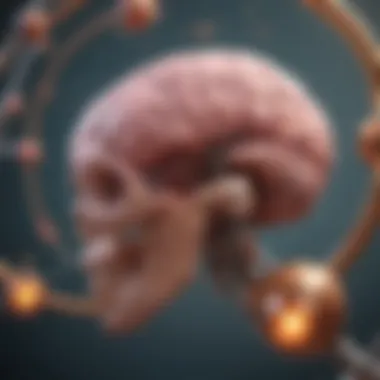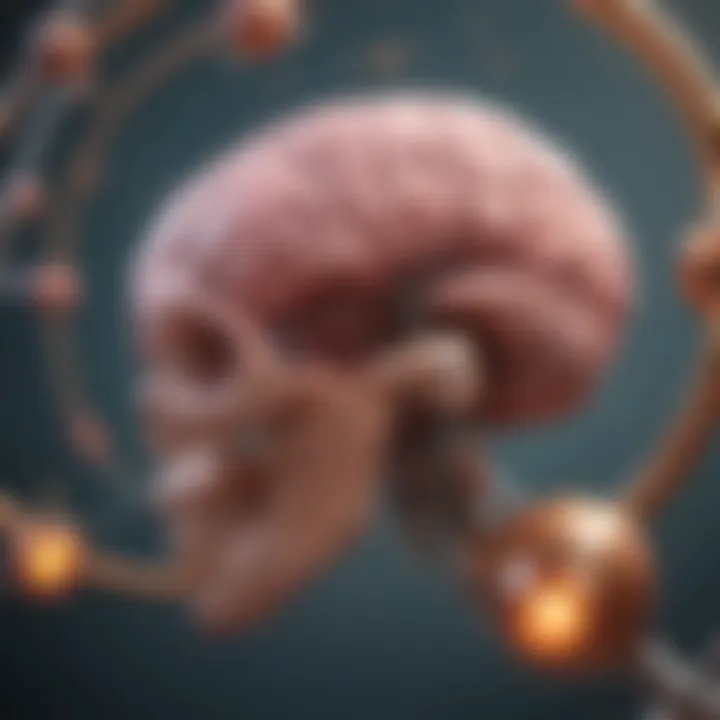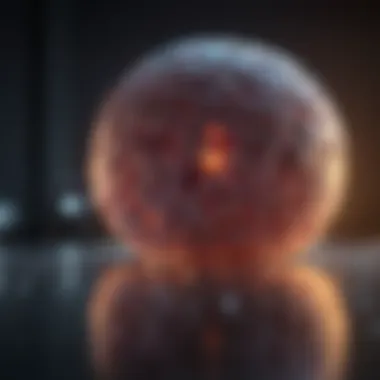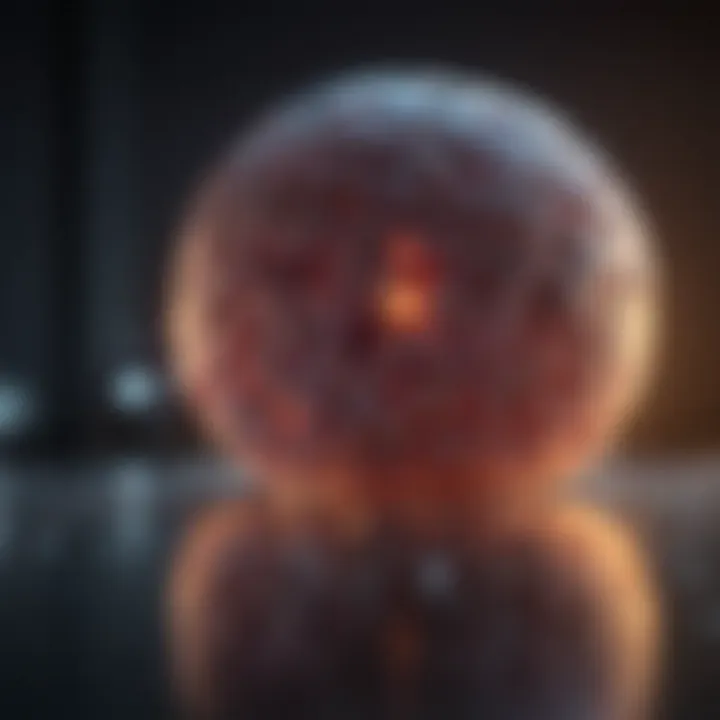GBM Chemotherapy: Mechanisms and Future Directions


Intro
Glioblastoma multiforme (GBM) is one of the most formidable adversaries in oncology. This aggressive brain tumor not only defies easy treatment but often evades the watchful eyes of even seasoned specialists. Given the complexity of this malignancy, understanding chemotherapy's role in managing GBM is essential. Chemotherapy has indeed transformed the landscape of cancer treatment, but in the case of GBM, its effectiveness often comes into question.
By examining the mechanisms through which chemotherapeutic agents function, this article takes a closer look at how these treatments can be both a weapon and, paradoxically, a double-edged sword. The efficacy of current protocols will be evaluated, offering insights on what is working and what isn’t.
Moreover, the article will venture into the future prospects of GBM chemotherapy, illuminating emerging therapies and the pathways being paved towards better patient outcomes. As we delve into this intricate topic, it becomes imperative to highlight the challenges faced in treatment, guiding the discussion towards a more nuanced understanding of GBM chemotherapy—a subject pivotal to the ongoing fight against this relentless condition.
Prolusion to GBM and Chemotherapy
Glioblastoma multiforme (GBM) represents one of the most formidable challenges in neuro-oncology. As a highly aggressive brain tumor, it not only poses significant health risks but also complicates treatment strategies. Understanding the intersection of GBM and chemotherapy is imperative, as this article aims to shed light on both fundamental knowledge and latest advancements regarding this dreadful disease. The significance of chemotherapy in treating GBM cannot be overstated. It serves as a crucial backbone in therapeutic regimens even when surgical interventions and radiotherapy come into play.
Chemotherapy specifically targets the rapidly dividing cancer cells, aiming to disrupt their growth and survival. But the landscape is not as straightforward as it seems. GBM's notorious characteristics – including its cellular diversity and ability to create a protective environment – can hinder the effectiveness of traditional chemotherapy. By delving into the mechanisms of GBM and chemotherapy, we can better appreciate the complexities involved in therapy selection and implementation. Furthermore, this examination is not just academic; it has real-world implications for patient management and outcome maximization.
Characteristics of Glioblastoma Multiforme
GBM is known for its aggressive nature and complex biological characteristics. Primarily, it exhibits a high degree of cellular heterogeneity. This means that varying subtypes of tumor cells can coexist, contributing to treatment resistance and making it difficult to apply a one-size-fits-all approach.
- Infiltrative Growth: GBM cells are notorious for infiltrating normal brain tissue, complicating surgical resection. Their spread into surrounding regions can give rise to recurrence, often in areas that are hard to target with conventional therapies.
- Genomic Alterations: Tumor progression in GBM involves multiple mutations in key oncogenes and tumor suppressor genes. These alterations affect pathways such as cell cycle regulation, apoptosis, and repair of DNA damage, presenting a moving target for therapies.
- Microenvironment Influence: The tumor microenvironment plays a pivotal role in the behavior of GBM cells. It includes factors such as hypoxia and a unique extracellular matrix, which can promote tumor survival and further complicate treatment strategies by creating barriers against drug penetration.
Chemotherapy in Oncology
Chemotherapy remains an essential tool in the oncologist's arsenal, particularly for aggressive tumors like GBM. It offers a systemic approach to combat cancer cells that may elude localized treatments.
- Mechanisms of Action: Chemotherapeutic agents work by exploiting the vulnerabilities in cancer cell biology, primarily focusing on DNA and RNA synthesis inhibition, and thereby preventing cancer cell proliferation.
- Combination Therapies: In most GBM treatment plans, chemotherapy is rarely given in isolation. It often works alongside other modalities, like radiation, enhancing the overall effectiveness by targeting multiple pathways within tumors.
- Evolution of Agents: Over time, a variety of chemotherapeutic agents have emerged to treat GBM, each with distinct profiles of efficacy and toxicity. Understanding their specific roles in treatment not only assists clinicians in formulating effective treatment regimens but also informs ongoing discussions about emerging therapies and the future landscape of GBM management.
This introduction sets the stage for a detailed exploration of GBM, its treatment intricacies, and the multifaceted role chemotherapy plays in fighting this aggressive malignancy. Understanding these key components will empower clinicians, researchers, and patients alike towards navigating the challenging terrain of GBM treatment.
Mechanisms of Action in GBM Chemotherapy
In the realm of oncology, understanding how chemotherapeutic agents act against glioblastoma multiforme (GBM) is critical. The mechanisms of action for chemotherapy in GBM inform not only the efficacy of treatments but also the potential for resistance that may arise. By breaking down these mechanisms, we can appreciate the complex interplay between these drugs and tumor cells.
Cell Cycle Disruption
The cell cycle is a finely tuned sequence of events that cells undergo to duplicate and divide. Chemo drugs often target this cycle, aiming to halt the unfettered growth of cancer cells. For instance, some agents directly interfere with DNA synthesis during the S phase or disrupt the mitotic spindle during mitosis, effectively preventing cells from properly dividing. This targeted approach is paramount because GBM cells are notorious for rapid proliferation.
But here’s the kicker: not all cells in a tumor respond uniformly. Some cells might be in a resting phase, which makes them less susceptible to these interventions. Thus, understanding which cells are cycling versus those that are dormant can be crucial for treatment planning.
Induction of Apoptosis
Apoptosis, or programmed cell death, is another avenue through which chemotherapy exerts its effects. By triggering apoptotic pathways, chemotherapeutic agents can effectively force cancer cells to self-destruct. This process involves a cascade of events that culminate in cell death, often mediated by specific proteins.
For instance, Temozolomide, a common drug used in the treatment of GBM, can lead to DNA damage that activates these pathways. However, it’s not always a one-size-fits-all scenario. Tumor cells may develop mechanisms to evade apoptosis, making it essential to consider therapies that can enhance these pathways or prevent the survival signals that keep malignant cells alive.


Targeting Tumor Microenvironment
Lastly, the tumor microenvironment plays a pivotal role in GBM progression and therapy response. This environment is a complex mix of cells, extracellular matrix, and signaling molecules that can hinder or promote tumor growth. Chemotherapy doesn't just target the tumor cells; it also aims to alter this surrounding environment.
Efforts to modify the microenvironment may include therapies that disrupt the support system of tumor cells, such as the blood supply, or those that modulate the immune response. It’s a delicate balance; sometimes these strategies can inadvertently aid tumor growth if not precisely targeted. Striking the right chord in this interplay is vital for improving patient outcomes.
"The fight against GBM is not just a confrontation with cancer cells but a complex battle involving the entire tumor ecosystem."
In summary, the mechanisms through which chemotherapy influences GBM are multifaceted, concerning cell cycle interruption, apoptotic stimulation, and the manipulation of the surrounding tumor matrix. Each aspect plays a role in developing effective treatment protocols, making it imperative for ongoing research to fine-tune these approaches.
Current Chemotherapeutic Agents for GBM
Chemotherapy plays a pivotal role in the management of glioblastoma multiforme (GBM). This aggressive brain tumor presents unique treatment challenges, making the understanding of current chemotherapeutic agents crucial. In this section, we explore three key players in the chemotherapy landscape for GBM: Temozolomide, Carmustine, and Nitrosoureas. Each agent has its own set of characteristics, mechanisms, and implications for patient outcomes, providing insight into the ongoing battle against this formidable disease.
Temozolomide
Mechanism of Action
Temozolomide is a well-recognized oral alkylating agent used primarily in the treatment of GBM. Its mechanism involves the formation of DNA methylation at the O6 position of guanine. This alteration leads to a disruption in DNA replication and ultimately prompts cell death. Because it can cross the blood-brain barrier effectively, it's often favored for GBM treatment. However, a notable feature of Temozolomide is its dependency on the cellular environment; its efficacy can wane in tumor cells that repair O6-methylguanine damage effectively, which underscores a significant limitation in some patients.
Clinical Efficacy
The clinical efficacy of Temozolomide is well-documented, particularly when used in conjunction with radiotherapy. It’s beneficial as it prolongs overall survival compared to radiotherapy alone, as demonstrated in pivotal clinical trials. However, the unique dosage schedule, initially introduced as a first-line treatment, can lead to inconsistent results across various studies. While generally seen as an effective initial treatment, its limitations in certain patient populations cannot be ignored.
Resistance Mechanisms
Despite its advantages, resistance to Temozolomide emerges as a critical concern. A major player in this resistance is the MGMT (O6-methylguanine-DNA methyltransferase) enzyme, which repairs the DNA damage caused by the drug. Tumors with high MGMT expression often showcase resistance, leading to treatment failure. This characteristic feature not only limits efficacy for a subset of patients but also challenges oncologists in tailoring individualized therapies. Evaluating MGMT promoter methylation status has become a significant aspect of treatment planning.
Carmustine
Administration Methods
Carmustine, a nitrosourea agent, primarily targets GBM through intravenous or intracranial routes. It is often administered at intervals, and the ability to implant wafers of the drug directly into the tumor site is a unique feature. This method allows for localized treatment, significantly enhancing drug exposure directly where it’s needed, but also presents challenges regarding potential infection and complications accompanying surgical intervention.
Combination Therapies
Carmustine’s effectiveness can be amplified when used in combination with other agents. For instance, combining it with Temozolomide or radiotherapy may lead to synergistic effects. Such combination strategies also aim to counteract the development of resistance that individual agents may face. However, balancing the potential benefits against the increased toxicity presents a constant challenge, critically affecting the treatment landscape and patient quality of life.
Side Effects
Like all chemotherapeutic agents, Carmustine has its share of side effects. Commonly reported adverse effects include myelosuppression, pulmonary toxicity, and gastrointestinal disturbances. Such side effects can significantly impact patient adherence and overall treatment outcomes. It requires diligent monitoring and supportive care to manage these effects, complicating the treatment framework and necessitating a nuanced approach to patient management.
Nitrosoureas


Pharmacodynamics
The pharmacodynamics of Nitrosoureas, which include Carmustine and Lomustine, involve their capacity to induce alkylation of DNA. Their fat-soluble nature allows them to penetrate the blood-brain barrier effectively. However, a notable aspect is their delayed onset of action; while they might not show immediate effects, they can sustain therapeutic concentrations longer, providing prolonged efficacy. This quality makes them particularly interesting for long-term management in chronic cases of GBM.
Long-term Outcomes
Explorations into the long-term outcomes of Nitrosoureas indicate potential benefits when used as part of multimodal therapy. Longitudinal studies suggest that these agents can contribute to improved survival rates, although the specifics can vary widely based on individual tumor biology. Notably, the potential for late-onset toxicities—ranging from hematological concerns to secondary malignancies—poses significant challenges in assessing the overall risk-benefit ratio for patients receiving this class of drugs. Effective strategies to monitor and mitigate these risks remain vital in clinical practice.
Challenges in GBM Chemotherapy
The treatment landscape for glioblastoma multiforme (GBM), particularly through chemotherapy, is fraught with intricacies and hurdles that cannot be overlooked. Addressing the challenges inherent in GBM chemotherapy is essential for advancing treatment protocols and improving patient outcomes. Recognizing these challenges provides valuable insight into the complexities of the disease as well as the therapies employed to combat it. Here, we will delve into three predominant issues that practitioners and researchers need to navigate:
- Limitations posed by the blood-brain barrier
- The toxicity and adverse effects associated with treatments
- The significant tumor heterogeneity encountered in GBM patients
Each of these elements plays a crucial role in shaping the overall efficacy of chemotherapy in management strategies for GBM. Understanding these aspects aids in the formulation of innovative approaches, thus paving the way for future advancements in therapy.
Blood-Brain Barrier Limitations
One of the most formidable obstacles in treating GBM with chemotherapy is the blood-brain barrier (BBB). This physiological barrier is designed to protect the brain from harmful substances. However, it also inadvertently restricts the passage of many chemotherapeutic agents, significantly limiting their effectiveness.
This limitation presents a multifaceted problem for oncologists. For instance, while drugs may be effective in vitro, their bioavailability in the brain is often insufficient. Research has shown that certain molecules, depending on size and polarity, may struggle to permeate this barrier. This has led to exploration of various techniques to enhance drug delivery, such as:
- Nanoparticle-mediated delivery: Utilizing tiny particles to ferry drugs across the BBB.
- Convection-enhanced delivery: A method that circumvents the BBB altogether by directly infusing drugs into the tumor bed.
- Focused ultrasound: This innovative technique temporarily disrupts the BBB, allowing therapeutic agents to enter the brain more effectively.
These strategies highlight the urgent need for continued research to develop methods that can effectively circumvent BBB limitations while ensuring safety and minimizing side effects.
Toxicity and Adverse Effects
It’s no secret that chemotherapy comes with its own bag of tricks in the form of side effects. The treatment regimen for GBM often leads to acute and chronic toxicity, impacting the overall quality of life for patients. Chemotherapeutic agents such as temozolomide or carmustine may produce a range of adverse effects, including:
- Nausea and vomiting
- Fatigue
- Myelosuppression, which reduces blood cell counts and increases infection risk
- Cognitive dysfunction, affecting memory and concentration
While some side effects are well-managed within clinical settings, persistent toxicity can lead patients to forego necessary treatments, directly impacting the effectiveness of the overall approach. Efforts to mitigate these adverse effects are crucial. This includes enhancing supportive care measures in the clinical setting and searching for alternative agents that exhibit similar efficacy with fewer toxicities.
Tumor Heterogeneity
Moreover, GBM is characterized by significant tumor heterogeneity—where the cellular composition within a single tumor can vary markedly. This diversity means that responding tumour cells may differ vastly from non-responsive ones, complicating treatment options. When chemotherapy targets a particular pathway, it may succeed in obliterating certain cell populations but may leave behind resistant cells that could lead to recurrence.
Understanding this heterogeneity is paramount in tailoring treatment strategies. A few key points to consider include:
- Molecular profiling: Identifying specific genetic markers can assist in predicting a patient’s response to certain chemotherapeutics.
- Clouding the therapeutic window: Tumor cells with distinct genetic mutations may react differently to the same doses of chemotherapy.
- Adaptive treatment strategies: Adjusting treatment plans on-the-fly to better address the evolving makeup of a patient’s tumor.
In summary, the challenges presented by blood-brain barrier limitations, toxicity and adverse effects, and significant tumor heterogeneity call for a critical assessment of current chemotherapy protocols. By illuminating these issues, researchers and clinicians can push the boundaries of existing knowledge and contribute to advancing effective care for GBM patients.


Innovations and Future Directions
As the landscape of oncology continues to evolve, the realm of glioblastoma multiforme (GBM) therapy is undergoing a significant transformation. This section aims to shed light on the importance of innovative strategies that have potential to revolutionize how we approach chemotherapy for GBM. With the limitations of current practices becoming more evident, it’s crucial to explore new avenues that not only promise enhanced efficacy but also improved patient quality of life. By understanding these innovations, we can better appreciate the trajectory of GBM treatments and their broader implications for cancer therapy overall.
Novel Chemotherapeutic Agents
The quest for novel chemotherapeutic agents is paramount in addressing the challenges posed by GBM. Traditional drugs, while somewhat effective, often fall short in long-term outcomes due to tumor resistance mechanisms. For instance, researchers are now investigating next-generation drug formulations, which include agents like Valproic Acid and Nab-paclitaxel, known for their ability to cross the blood-brain barrier more effectively than their predecessors.
These new agents focus on dual-targeting approaches, inhibiting tumor cell proliferation while simultaneously promoting apoptosis. This shifts the paradigm from merely stalling tumor growth to actively engaging with the underlying biological processes driving GBM, thus enhancing overall treatment efficacy.
Some agents are also being designed to avoid the pitfalls of toxicity that many current therapies bear. By employing nanotechnology, these treatments can specifically direct their action to tumor sites, minimizing damage to healthy brain tissue. This targeted approach holds promise not just in increasing survival rates but also for preserving the quality of life for patients battling this relentless disease.
Personalized Medicine Approaches
The application of personalized medicine in GBM treatment signifies a transformative step forward. This approach hinges on tailoring therapies based on the genetic makeup and molecular profile of individual tumors. As every GBM is unique, understanding its specific characteristics allows clinicians to devise highly personalized treatment plans that potentially enhance responsiveness to therapy.
One striking case is the use of Genetic Profiling technologies, which help in identifying specific mutations within a patient’s tumor. Treatments can then be honed to target these mutations effectively, maximizing efficacy while doing away with the one-size-fits-all model that has faltered in traditional chemotherapy.
Moreover, utilizing biomarkers for monitoring treatment response provides a more dynamic method of adjusting therapies according to how a tumor reacts over time. Such adaptability is essential, especially in a disease as aggressive as GBM, where time is invariably of the essence.
Integration of Immunotherapy
The integration of immunotherapy into GBM treatment regimens marked a revolutionary shift in oncologic approaches. Unlike conventional strategies that predominantly focus on eradicating cancer cells, immunotherapies enhance the body's own immune responses to recognize and fight tumors.
One of the leading methods is checkpoint inhibitors, which unblock the pathways cancer cells use to evade immune attack. CAR T-cell therapy, another innovative approach, modifies a patient’s T-cells to better identify and destroy GBM cells. While still largely in the experimental stages for GBM, initial findings have sparked hope among researchers and clinicians alike, emphasizing the need for further exploration.
Combining immunotherapy with traditional chemotherapeutics could also yield synergistic effects. Such combinations could capitalize on the immune system's capacity to attack cancer while utilizing the rapid proliferative disadvantages of many chemotherapeutic agents. The ongoing clinical trials exploring these intersections can pave the way towards a more effective and comprehensive treatment pipeline for GBM patients.
“Innovations in GBM therapy represent not just a change in treatment options, but a renewal of hope for many facing this formidable adversary.”
Epilogue and Implications for Research
As we draw the curtain on this exploration of GBM chemotherapy, it becomes evident that the landscape of treatment is both complex and evolving. The findings presented throughout this piece illuminate the multifaceted approaches currently in practice, alongside the underlying mechanisms that define their efficacy. Importantly, it is clear that chemotherapy remains a cornerstone in the therapeutic arsenal against glioblastoma multiforme, even as we grapple with its limitations and challenges.
In summary, successful management of GBM isn’t merely about selecting the right chemotherapeutic agents. Rather, it requires a holistic consideration of factors like patient-specific variabilities, tumor characteristics, and advancements in technology. Chemotherapy must adapt to the ever-shifting nature of GBM's biology and the associated resistance mechanisms that often thwart treatment plans.
Summary of Findings
The insights gathered in this article reveal several key points:
- Chemotherapeutic agents, like temozolomide and carmustine, exhibit unique action mechanisms that contribute to their effectiveness against GBM cells.
- Resistance mechanisms pose significant challenges. Understanding these can lead to better therapeutic strategies.
- The interplay between chemotherapy and patient-specific factors, including genetic makeup and environmental influences, calls for a more individualized treatment approach.
- Innovative strategies, including the integration of immunotherapies, are promising avenues toward enhancing treatment efficacy in GBM.
"If we are to advance in the management of GBM, we must not shy away from investigating the limitations we face and turning challenges into opportunities for further discovery."
Call for Further Research
One cannot emphasize enough the need for further research in this domain. The field is rife with unexplored avenues that merit attention:
- Investigating new drug combinations can potentially overcome resistance mechanisms and improve patient survival rates.
- Exploring gene therapy may present revolutionary ways to target GBM at its core, disassembling its aggressive lifecycle.
- Collaborations across various medical disciplines, including geneticists, neurologists, and oncologists, can yield novel approaches that enrich current understanding and application of treatments.
- Continuous studies into the socioeconomic impacts of GBM treatments can help tailor research to the populations that need them most.
- The exploration of patient-reported outcomes should also be prioritized to gauge the effectiveness and quality of life that these therapies afford individuals battling GBM.
In closing, while we have made strides in the fight against GBM with chemotherapy, the journey is far from over. We must continually push the boundaries of research so we can unravel the intricate web of this formidable disease, thus paving the way for improved treatment modalities and enhanced patient outcomes.



